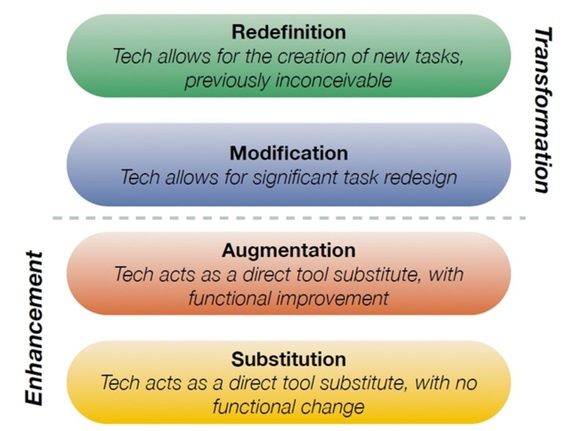So, your first question is probably what are SAMR and TPACK. Allow me to enlighten you dear readers.
SAMR
The SAMR model is a means for evaluating the implementation of technology in the classroom.
Let me break it down more for you. SAMR stands for Substitution, Augmentation, Modification and Redefinition (Romell, Kidder, & Wood, 2014). Below is a visual representation.
 |
| Source: http://www.schrockguide.net/uploads/3/9/2/2/392267/5805548.jpg?579 |
Basically, each task that teachers do or assign to their students using technology will fall somewhere on this model. Try to think of it like Bloom's taxonomy with the lower order thinking skills situated at the bottom of the pyramid and the higher order thinking skills at the very top. As such, the role of technology increases with each step upwards
For the listeners:
Source: https://www.youtube.com/watch?v=us0w823KY0g
Simple assignments fall within the realms of substitution and augmentation. In substitution the technology replaces traditional learning tools, like pen and paper. When an activity is augmented the task is improved functionally when the technology is used in place of a traditional learn tool.
More complex tasks arise from modification and redefinition. When an assignment using technology is done the manner in which the task is completed has undergone a significant overhaul. For example, Romell, Kidder, & Wood (2014) presented the reader with an exercise in using SMS-alerts to simulate updates that occurred during a hypothetical natural disaster. Redefinition of tasks happens when a completely new assignment is created and carried out that was not possible before the technology being used existed.
In case you, dear reader, need some examples and are unsure of how to classify technology, in this case iPad apps, here are some designated by the SAMR model, as well as Bloom's taxonomy. In case the picture is too small or unclear here is a short list for the four steps of SAMR...
Substitution: Facebook, Twitter, Calculator, iBooks
Augmentation: Pages, Comic Life, Quick Voice
Modification: Skype, Mind Mash, Dragon Dictation, AIM
Redefinition: Wordpress, Prezi, Creative Book Builder
 Source: Gandol, F. (2013). Modelo SAMR y clasificacion iPad Apps. Blog de iDidactic. Retrieved on March 22, 2015 from http://www.ididactic.com/edblog/modelo-samr-y-clasificacion-ipad-apps/ |
TPACK TIME!
TPACK is a framework that describes how teachers use their knowledge of pedagogy (how you teach), content (what you teach) and technology (what technologies or software are available) to successfully integrate technology in the classroom (Koehler & Mishra, 2009).
Here is a short video that explains TPACK:
Source: https://www.youtube.com/watch?v=FagVSQlZELY
When a teacher employs their knowledge of all three aspects not only are they more able to successfully integrate technology, but also make knowledge and information more accessible to students.
In the picture below are some pedagogical methods teachers can use, various technologies available and some concepts of what content knowledge includes.
 |
| Source: https://www.smore.com/w1cj-tpack-as-a-model-for-change |
Personally, I don't identify with one model over the other, but feel that they must work in tandem to provide the best education and integration of technology into the classroom. Being able to understand which pedagogical methods and variants technology work best with the content that must be learned is key (TPACK). Simultaneously, SAMR is also employed.
Many students in this modern day and age have access to things like smartphones and tablets of various sorts, however this does not mean that they know how to learn with these extra limbs.
Technology and its tools must be introduced, modeled and practiced before their full potential comes to fruition. Therefore, technology integration will most likely occur on the lowest step of SAMR-- substitution. Students can use laptops, PCs, tablets, smartphones, smartboards, projectors and many other mediums. Determining which is suitable is not an easy task.
As students become more comfortable with using technology to learn and not just surf the internet or play angry birds, teachers can begin to augment various tasks. The methods teachers utilize for delivering information, pedagogy, will differ depending on the assignment.
When students are ready to complete tasks that fall within the stages of modification and redefinition the technological knowledge teachers have will to expand to reap the most benefits of these transformative tasks. Again the pedagogical knowledge will show more variety, especially as new tasks and assignments are created.
Underlying all of this growth and vertical movement within the SAMR model is a solid foundation of content knowledge that is enhanced and cultivated by the technological and pedagogical knowledge a teacher has.
And so, because education is not a simple balance of scales, but a system in constant flux in an attempt to maintain equilibrium I leave you with a picture worth a thousand words.
 |
| Source: https://blogger.googleusercontent.com/img/b/R29vZ2xl/AVvXsEg7L1HJ3piN9FlpWPFiAyIyqtML3k15VFrFv9P1U8k2eKO83z2gjRb1cOHjsIl2hv5TnaRK_KL_NCfFHoUiBdsFpDgjVU8_OoKg1l10epDGfQy0v_j5jZ06HAIfT9lWO2S_vWfCu8pkgWI/s1600/_.SAMR,+BLOOMS+TAXONOMY+AND+DOK+TABLE+OF+COMPARISON-page-001.jpg |
I really like your images and gifs you included! :)
ReplyDeleteYour explanation of SAMR was so easy to understand and I LOVED the circle chart of all the different technologies that fall into each level!
ReplyDelete